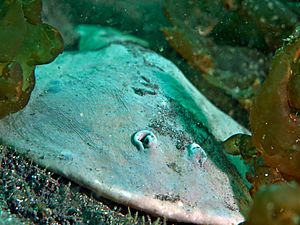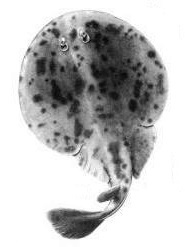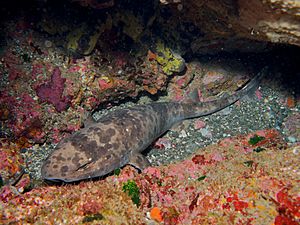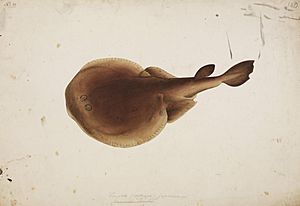Japanese sleeper ray facts for kids
Quick facts for kids Japanese sleeper ray |
|
|---|---|
 |
|
| Conservation status | |
| Scientific classification | |
 |
|
| Geographic range | |
| Synonyms | |
|
Torpedo japonica Temminck & Schlegel, 1850 |
The Japanese sleeper ray (Narke japonica) is a type of electric ray. It belongs to the family called Narkidae. This ray lives in the Pacific Ocean, from southern Japan to southern China. You can find it in waters close to shore and further out.
This ray can grow up to 40 cm (16 in) long. It has a round body shape, like a disc. Its color is usually reddish to chocolate brown on top. Sometimes, it has darker or lighter spots. The underside is a lighter brown. Behind its small eyes are special openings called spiracles. These spiracles have smooth, raised edges. The ray's tail is short and strong. It has one dorsal fin (top fin) located behind its rounded pelvic fins (bottom fins). The tail ends with a large caudal fin (tail fin).
The Japanese sleeper ray lives on the sea floor in shallow, sandy areas. It often stays near rocky reefs. It is a predator that hunts small creatures without backbones, called invertebrates. Like other electric rays, it can create a strong electric shock. It uses this shock to protect itself from danger. Female rays give live birth to up to five young at a time. The baby rays first get food from a yolk sac. Later, they get a special "uterine milk" from their mother. The International Union for Conservation of Nature (IUCN) says this species is Vulnerable. This means it is at risk because of fishing nets called trawls. These nets are used a lot where the ray lives.
Contents
About the Japanese Sleeper Ray
The Japanese sleeper ray was first studied by scientists in the 1800s. German naturalists collected some of these fish in Japan. Later, two scientists, Coenraad Jacob Temminck and Hermann Schlegel, officially described the species in 1850. They gave it the scientific name Narke japonica.
Other common names for this ray include the Japanese electric ray. Some scientists think this ray might be the same as another species called the sleeper torpedo. This is because they look very much alike.
What Does It Look Like?
The Japanese sleeper ray has a body shaped like a wide, almost round disc. It is wider than it is long. Under its skin, on each side of its head, are two large, kidney-shaped electric organs. These are what produce the electric shock.
Its eyes are small and stick out a little. Right behind the eyes are larger openings called spiracles. These spiracles have raised, smooth edges. The ray's nostrils are small and close together. Between them is a flap of skin that covers its mouth. The mouth is small and can be pushed out. It has a deep groove around it.
Inside its mouth, the ray has fewer than 25 rows of teeth in each jaw. These teeth are small with oval bases and pointed tips. On the underside of its body, it has five pairs of short gill slits.
The pelvic fins are large and wide. They start under the pectoral fins. Adult male rays have small parts called claspers. These are used for reproduction and do not go past the pelvic fins. The tail is short and thick, with a fold of skin along each side.
The ray has one rounded dorsal fin (top fin) located behind its pelvic fins. Its large caudal fin (tail fin) is almost the same size on the top and bottom. It has rounded corners. The ray's skin is soft and does not have rough scales like some other fish.
The Japanese sleeper ray is usually reddish to chocolate brown on its upper side. Its underside is a lighter brown. Some rays are plain, while others have dark or light spots on their backs. Very rarely, they might have spots on their undersides too. The biggest Japanese sleeper ray found was about 40 cm (16 in) long.
Where It Lives
The Japanese sleeper ray lives in the northwestern Pacific Ocean. You can find it in the waters over the continental shelf. Its home range stretches from southern Japan and Korea to southeastern China and Taiwan.
This ray is common and lives on the sea floor. It likes sandy areas, often close to rocky reefs. It can be found both near the shore and further out in the ocean. Off the Izu Peninsula in Japan, it has been seen at depths of 12 to 23 meters (39 to 75 feet).
Biology and Life Cycle
The Japanese sleeper ray is not very active. It spends a lot of its time lying still, often buried in the sand on the sea floor. If it feels threatened, it can produce an electric shock of 30–80 volts. This shock helps it scare away predators. One known predator is the blotchy swell shark.
The ray's electric organs are made of special cells called electrocytes. These cells come from muscle fibers and are filled with a jelly-like substance. The electrocytes are stacked in tall columns, like tiny batteries connected together. This setup allows them to create a powerful electric discharge.
The Japanese sleeper ray eats small creatures that live on the sea floor, such as invertebrates.
Reproduction
The Japanese sleeper ray gives live birth to its young. The developing baby rays, called embryos, first get food from a yolk sac. As they grow, they are nourished by a special liquid called histotroph. This "uterine milk" is produced by the mother.
Females usually give birth to litters of up to five pups in the early summer. When they are born, the newborns are about 10 cm (3.9 in) long. They are also lighter in color and have a more even color than the adult rays. Male rays become ready to reproduce when they are between 23 and 37 cm (9.1 and 15 in) long. Females are ready when they are around 35 cm (14 in) long.
Human Interactions and Conservation
The electric shock from a Japanese sleeper ray is strong, but it is not dangerous to humans. There was one time a ray reacted to a camera by rubbing its back against it. This suggests that they might actively defend themselves if they feel bothered. These rays do not do well when kept in aquariums.
Scientists study electric rays, including this species, for medical research. Their electric organs have many special parts that are similar to those in the human nervous system. This makes them useful for understanding how our own bodies work.
The Japanese sleeper ray is often caught by accident in fishing nets. These nets are used to catch shrimp and other fish that live on the bottom of the ocean. The ray is not usually caught on purpose for food. However, electric rays often do not survive after being caught and thrown back into the ocean. Shrimp fishing is very common in East Asia. Because of this, the International Union for Conservation of Nature (IUCN) has listed the Japanese sleeper ray as Vulnerable. This means its population is decreasing and it needs protection.
Images for kids








